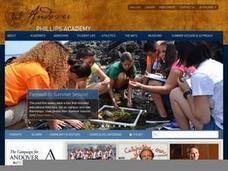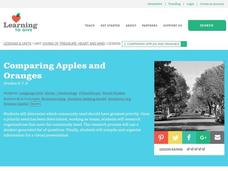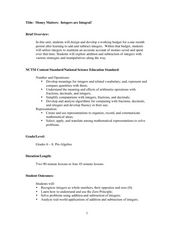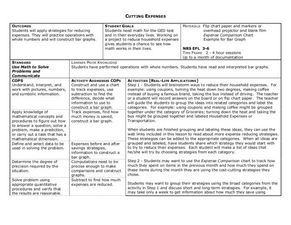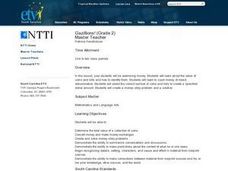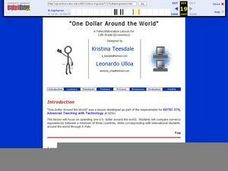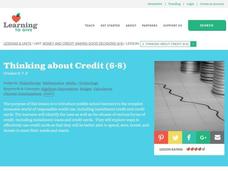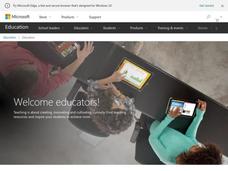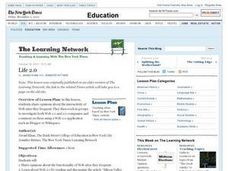Visa
Money Matters: Why It Pays to Be Financially Responsible
What does it mean to be financially responsible? Pupils begin to develop the building blocks of strong financial decision making by reviewing how their past purchases are examples of cost comparing, cost-benefit analysis, and budgeting.
National Association of Teacher Educators for Family and Consumer Science
Consumerism in the Classroom: Effective Strategies for Today's Teenage Consumers
Help class members become savvy consumers with a series of activities that has them analyzing marketing strategies, comparing the value of brand name versus off-brand clothing, and considering the advantages and...
Curated OER
Compare and Contrast: Hershey and Mars
Twelfth graders compare and contrast information from stories. In this similarities and differences lesson, 12th graders read about Milton Hershey and Forrest S. Mars to learn about the lives of the two men. Students complete...
Curated OER
Investing Money
Sixth graders participate in an simulated investment activity. They examine the purpose of different types of investments before they predict which will be the most successful. Finally, they simulate investing $1,000 in stocks, $1,000 in...
Curated OER
Money, Banks, & Financial Institutions
Students engage in a study of financial institutions that includes the banking industry. They participate in a research study using different resources. They are introduced to the concept of bartering and how it is used as a replacement...
Curated OER
Comparing Apples and Oranges
Middle schoolers understand that many organizations in the community have needs. In this philanthropy activity, students research pros and cons of a philanthropic organization. Middle schoolers create a multimedia presentation to show...
Advocates for Human Rights
Human Rights Defined
Class members continue their investigation of the factors that influence migration with a lesson on human rights. As they examine the Universal Declaration of Human Rights and selected US Constitutional Amendments, learners compare the...
National Security Agency
Money Maters: Integers are Integral!
A thoroughly-written lesson plan and a plethora of worksheets about integers comprise this resource. Neophyte number crunchers learn to recognize integers, add and subtract them, and apply the concepts to the designing of a personal...
Curated OER
A Gift for Mama
Students read a novel about savings and complete activities to define short and long term saving goals. In this income and savings lesson, students read A Gift for Mama and answer discussion questions for it. Students define the terms...
Curated OER
How Are Coins Different?
Students use sets of circulating coins to determine the unique characteristics of each coin. They create paragraphs and illustrations to convey what makes each coin in our pockets special.
Curated OER
Cutting Expenses
Learners explore budgeting. In this finance and math lesson, students brainstorm ways in which households could save money. Learners view websites that give cost reducing ideas. Students complete an expense comparison chart and use the...
Curated OER
The Value of Education
The real value of education is highlighted in more than one way on a worksheet designed to not only add, subtract, multiply, and divide decimals to hundredths, but also to address the correlation between higher pay...
Curated OER
Gazillions!
Second graders determine the total value of a collection of coins. They convert money and make money exchanges. Students create and solve money-story problems. They demonstrate the ability to summarize conversations and discussions.
Curated OER
Metal Composition & the U.S. Mint
Students study the meaning, symbolism, and value of U.S. coins,
especially the quarter. Theyresearch why in 1965 the U.S. Mint decided to
change the metal composition of the quarter to copper coated with nickel.
In addition, they perform...
Curated OER
One Dollar Around the World
Twelfth graders collaborate via ePals with another student from another country. They compare the value of a dollar with its power of acquisition in other countries. They list one dollar items and find the corresponding price in other...
Curated OER
Campaign Signs and Pranksters
Students collect campaign literature and investigate what signs local candidates are using. Students contact local politicians/candidates and interview them about the concepts and creation of their campaign literature. Students compare...
Curated OER
Thinking About Credit
Students examine the use of credit such as installment purchases and credit cards. For this credit lesson, students learn the vocabulary associated with credit usage such as mortgage, credit report/score, and debit cards. They determine...
California Department of Education
Choosing My Lifestyle
How much does it cost to live the life your dream life? Scholars explore the pitfalls of personal finance through planning, discussion, and research. The first lesson in a five-part series tasks individuals with determining an...
Humanities Texas
Primary Source Worksheet: Citizen Letters to President and Mrs. Roosevelt Concerning the Depression
A letter addressed to President Roosevelt and another addressed to Eleanor Roosevelt offer insight not only into these two amazing historical figures, but also into the struggles people faced during the Great Depression.
Curated OER
Current Currencies
Students explore the nature of money and how foreign exchange rates work. They write reports based on their research.
Curated OER
Smart Consumers, Smart Choices
Students see what it means to be a smart consumer by engaging in a level-headed analysis of budget, opportunity costs and self-regulation. They compare prices within a service field, and weigh the choices of spending money on that item.
Curated OER
Why Eat Organic?
Ninth graders explore the concept of organic eating. In this environmental stewardship lesson, 9th graders compare and contrast organic foods with conventional foods and discuss the benefits of eating organic foods.
Curated OER
Million Dollar Project
Each student is given the task of spending $1 million. The way students spend their money is dependent on a theme such as "creating a dream world," "taking a trip," or "doing something to better society." Each student researches,...
Curated OER
Life 2.0
Pupils share opinions about the interactivity of Web sites they frequent. They compare and contrast Web 1.0 and Web 2.0 applications. Students work in groups to investigate both Web 1.0 and 2.0 companies and comment on them using a Web...




